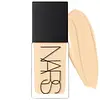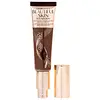NARS Cosmetics Light Reflecting Advanced Skincare Foundation Versus Charlotte Tilbury Beautiful Skin Foundation
What's inside
What's inside
 Key Ingredients
Key Ingredients

 Benefits
Benefits

 Concerns
Concerns

 Ingredients Side-by-side
Ingredients Side-by-side

Water
Skin ConditioningC9-12 Alkane
SolventButylene Glycol
HumectantUndecane
EmollientTridecane
PerfumingIsodecyl Neopentanoate
EmollientHydrogenated Polyisobutene
EmollientPolyglyceryl-6 Polyricinoleate
EmulsifyingPolyglyceryl-2 Diisostearate
EmulsifyingDisteardimonium Hectorite
StabilisingDiisostearyl Malate
EmollientGlycerin
HumectantSynthetic Wax
AbrasiveSodium Chloride
MaskingOphiopogon Japonicus Root Extract
Skin ConditioningAscophyllum Nodosum Extract
Skin ConditioningTheobroma Cacao Seed Extract
AntioxidantCurcuma Longa Root Extract
MaskingSilybum Marianum Fruit Extract
Skin ConditioningAluminum Hydroxide
EmollientMagnesium Chloride
Sodium Dilauramidoglutamide Lysine
HumectantTocopherol
AntioxidantCoco-Caprylate/Caprate
EmollientEthylhexylglycerin
Skin ConditioningPentylene Glycol
Skin ConditioningHydroxyphenyl Propamidobenzoic Acid
Skin ConditioningAscorbyl Palmitate
AntioxidantCitric Acid
BufferingSea Water
HumectantTrisodium EDTA
CI 77120
Cosmetic ColorantAlumina
AbrasiveChlorphenesin
AntimicrobialPhenoxyethanol
PreservativePotassium Sorbate
PreservativeIron Oxides
Mica
Cosmetic ColorantCI 77891
Cosmetic ColorantWater, C9-12 Alkane, Butylene Glycol, Undecane, Tridecane, Isodecyl Neopentanoate, Hydrogenated Polyisobutene, Polyglyceryl-6 Polyricinoleate, Polyglyceryl-2 Diisostearate, Disteardimonium Hectorite, Diisostearyl Malate, Glycerin, Synthetic Wax, Sodium Chloride, Ophiopogon Japonicus Root Extract, Ascophyllum Nodosum Extract, Theobroma Cacao Seed Extract, Curcuma Longa Root Extract, Silybum Marianum Fruit Extract, Aluminum Hydroxide, Magnesium Chloride, Sodium Dilauramidoglutamide Lysine, Tocopherol, Coco-Caprylate/Caprate, Ethylhexylglycerin, Pentylene Glycol, Hydroxyphenyl Propamidobenzoic Acid, Ascorbyl Palmitate, Citric Acid, Sea Water, Trisodium EDTA, CI 77120, Alumina, Chlorphenesin, Phenoxyethanol, Potassium Sorbate, Iron Oxides, Mica, CI 77891
Water
Skin ConditioningPyrus Malus Fruit Water
MaskingDimethicone
EmollientMica
Cosmetic ColorantOctyldodecyl Stearoyl Stearate
EmollientCetyl PEG/PPG-10/1 Dimethicone
EmulsifyingHydrogenated Ethylhexyl Olivate
EmollientHydrogenated Polyisobutene
EmollientPropanediol
SolventGlycerin
HumectantTrimethylsiloxysilicate
EmollientPolyglyceryl-4 Isostearate
EmulsifyingSodium Chloride
MaskingLauroyl Lysine
Skin ConditioningDimethicone/Vinyl Dimethicone Crosspolymer
Skin ConditioningDisteardimonium Hectorite
StabilisingSodium Dehydroacetate
PreservativeHydrogenated Olive Oil Unsaponifiables
EmollientCaprylyl Glycol
Emollient1,2-Hexanediol
Skin ConditioningTriethoxycaprylylsilane
Sodium Gluconate
Skin ConditioningTocopheryl Acetate
AntioxidantMaltodextrin
AbsorbentBixa Orellana Seed Extract
MaskingPentylene Glycol
Skin ConditioningButylene Glycol
HumectantCassia Angustifolia Seed Polysaccharide
Skin ConditioningSodium Hyaluronate
HumectantCocos Nucifera Fruit Extract
EmollientAluminum Hydroxide
EmollientRosa Damascena Flower Oil
MaskingRosa Damascena Flower Water
MaskingPentaerythrityl Tetra-Di-T-Butyl Hydroxyhydrocinnamate
AntioxidantCI 77891
Cosmetic ColorantIron Oxides
Water, Pyrus Malus Fruit Water, Dimethicone, Mica, Octyldodecyl Stearoyl Stearate, Cetyl PEG/PPG-10/1 Dimethicone, Hydrogenated Ethylhexyl Olivate, Hydrogenated Polyisobutene, Propanediol, Glycerin, Trimethylsiloxysilicate, Polyglyceryl-4 Isostearate, Sodium Chloride, Lauroyl Lysine, Dimethicone/Vinyl Dimethicone Crosspolymer, Disteardimonium Hectorite, Sodium Dehydroacetate, Hydrogenated Olive Oil Unsaponifiables, Caprylyl Glycol, 1,2-Hexanediol, Triethoxycaprylylsilane, Sodium Gluconate, Tocopheryl Acetate, Maltodextrin, Bixa Orellana Seed Extract, Pentylene Glycol, Butylene Glycol, Cassia Angustifolia Seed Polysaccharide, Sodium Hyaluronate, Cocos Nucifera Fruit Extract, Aluminum Hydroxide, Rosa Damascena Flower Oil, Rosa Damascena Flower Water, Pentaerythrityl Tetra-Di-T-Butyl Hydroxyhydrocinnamate, CI 77891, Iron Oxides
 Reviews
Reviews

Ingredients Explained
These ingredients are found in both products.
Ingredients higher up in an ingredient list are typically present in a larger amount.
Aluminum Hydroxide is a form of aluminum. It can be naturally found in nature as the mineral gibbsite. In cosmetics, Aluminum Hydroxide is used as a colorant, pH adjuster, and absorbent.
As a colorant, Aluminum Hydroxide may add opacity, or reduce the transparency. Aluminum hydroxide is contains both basic and acidic properties.
According to manufacturers, this ingredient is an emollient and humectant. This means it helps hydrate the skin.
In medicine, this ingredient is used to help relieve heartburn and help heal ulcers.
There is currently no credible scientific evidence linking aluminum hydroxide in cosmetics to increased cancer risk.
Major health organizations allow the use of aluminum hydroxide in personal care products and have not flagged it as a carcinogenic risk at typical usage levels.
Learn more about Aluminum HydroxideButylene Glycol (or BG) is used within cosmetic products for a few different reasons:
Overall, Butylene Glycol is a safe and well-rounded ingredient that works well with other ingredients.
Though this ingredient works well with most skin types, some people with sensitive skin may experience a reaction such as allergic rashes, closed comedones, or itchiness.
Learn more about Butylene GlycolCi 77891 is a white pigment from Titanium dioxide. It is naturally found in minerals such as rutile and ilmenite.
It's main function is to add a white color to cosmetics. It can also be mixed with other colors to create different shades.
Ci 77891 is commonly found in sunscreens due to its ability to block UV rays.
Learn more about CI 77891Disteardimonium Hectorite comes from the clay mineral named hectorite. It is used to add thickness to a product.
It can also help stabilize a product by helping to disperse other ingredients.
Hectorite is a rare, white clay mineral.
Learn more about Disteardimonium HectoriteGlycerin is already naturally found in your skin. It helps moisturize and protect your skin.
A study from 2016 found glycerin to be more effective as a humectant than AHAs and hyaluronic acid.
As a humectant, it helps the skin stay hydrated by pulling moisture to your skin. The low molecular weight of glycerin allows it to pull moisture into the deeper layers of your skin.
Hydrated skin improves your skin barrier; Your skin barrier helps protect against irritants and bacteria.
Glycerin has also been found to have antimicrobial and antiviral properties. Due to these properties, glycerin is often used in wound and burn treatments.
In cosmetics, glycerin is usually derived from plants such as soybean or palm. However, it can also be sourced from animals, such as tallow or animal fat.
This ingredient is organic, colorless, odorless, and non-toxic.
Glycerin is the name for this ingredient in American English. British English uses Glycerol/Glycerine.
Learn more about GlycerinHydrogenated Polyisobutene is a synthetic polymer. Polymers are compounds with high molecular weight. Hydrogenated Polyisobutene is an emollient and texture enhancer.
In one study, Hydrogenated Polyisobutene showed better skin hydration levels than Caprylic/Capric Triglyceride. As an emollient, it helps keep your skin soft and hydrated by trapping moisture in.
Hydrogenated Polyisobutene is often used as a mineral oil replacement.
Learn more about Hydrogenated PolyisobuteneMica is a naturally occurring mineral used to add shimmer and color in cosmetics. It can also help improve the texture of a product or give it an opaque, white/silver color.
Serecite is the name for very fine but ragged grains of mica.
This ingredient is often coated with metal oxides like titanium dioxide. Trace amounts of heavy metals may be found in mica, but these metals are not harmful in our personal products.
Mica has been used since prehistoric times throughout the world. Ancient Egyptian, Indian, Greek, Roman, Aztec, and Chinese civilizations have used mica.
Learn more about MicaPentylene glycol is typically used within a product to thicken it. It also adds a smooth, soft, and moisturizing feel to the product. It is naturally found in plants such as sugar beets.
The hydrophilic trait of Pentylene Glycol makes it a humectant. As a humectant, Pentylene Glycol helps draw moisture from the air to your skin. This can help keep your skin hydrated.
This property also makes Pentylene Glycol a great texture enhancer. It can also help thicken or stabilize a product.
Pentylene Glycol also acts as a mild preservative and helps to keep a product microbe-free.
Some people may experience mild eye and skin irritation from Pentylene Glycol. We always recommend speaking with a professional about using this ingredient in your routine.
Pentylene Glycol has a low molecular weight and is part of the 1,2-glycol family.
Learn more about Pentylene GlycolChances are, you eat sodium chloride every day. Sodium Chloride is also known as table salt.
This ingredient has many purposes in skincare: thickener, emulsifier, and exfoliator.
You'll most likely find this ingredient in cleansers where it is used to create a gel-like texture. As an emulsifier, it also prevents ingredients from separating.
There is much debate on whether this ingredient is comedogenic. The short answer - comedogenic ratings don't tell the whole story. Learn more about comegodenic ratings here.
The concensus about this ingredient causing acne seems to be divided. Research is needed to understand if this ingredient does cause acne.
Scrubs may use salt as the primary exfoliating ingredient.
Learn more about Sodium ChlorideWater. It's the most common cosmetic ingredient of all. You'll usually see it at the top of ingredient lists, meaning that it makes up the largest part of the product.
So why is it so popular? Water most often acts as a solvent - this means that it helps dissolve other ingredients into the formulation.
You'll also recognize water as that liquid we all need to stay alive. If you see this, drink a glass of water. Stay hydrated!
Learn more about WaterThis ingredient is a combination of red, black, and yellow iron oxide pigments. This combination of colors is usually found in foundation, because it results in a "skin" color.